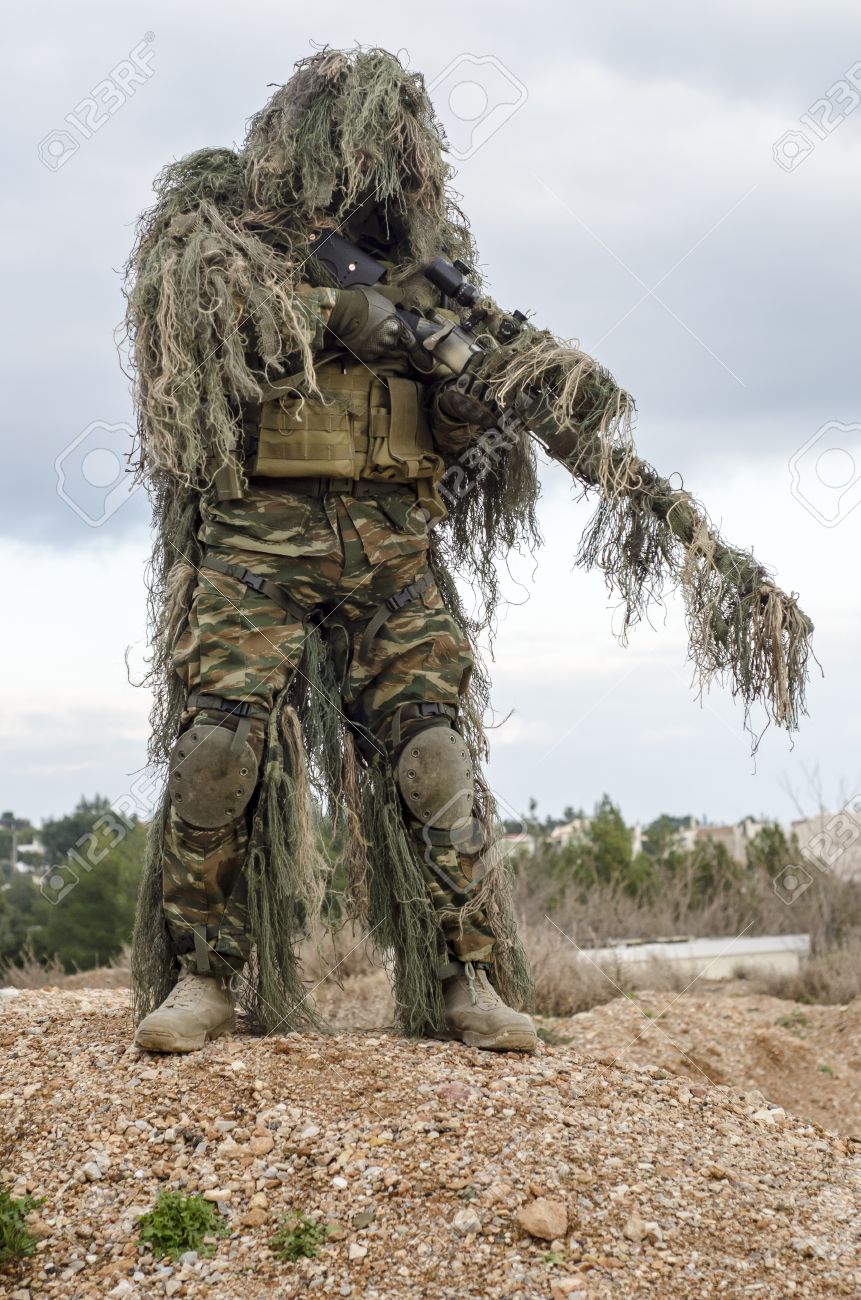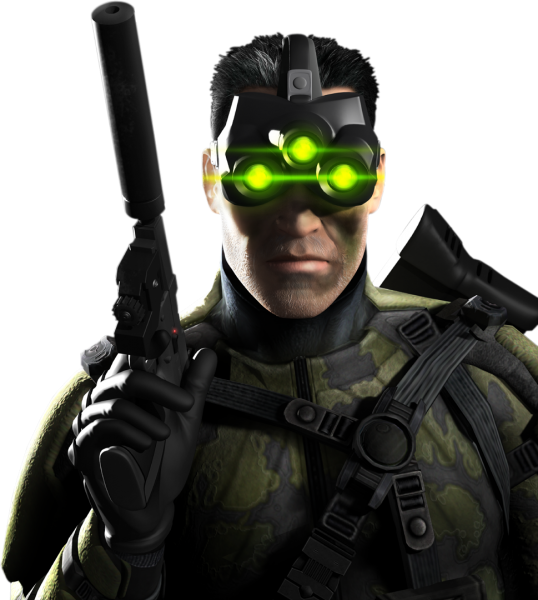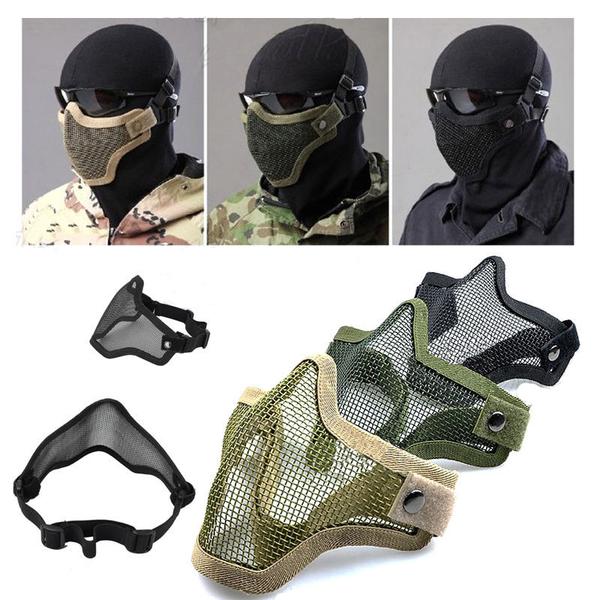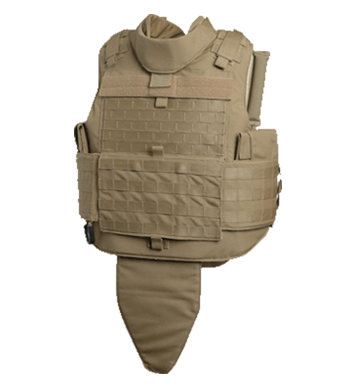GURPS Stealth and Camouflage Guide Part 1
All ghillied up
Stealth and Camouflage are skills that appear on variety of templates, are recommended for every soldier, mercenary and most adventurers, but a lot of questions come up when they're actually deployed in play, and a lot of tricks of the trade come ignored. Hopefully, this guide will clear these questions up and help both players and GMs to smartly utilize these skills in play.
The skills
Camouflage (BS183) - This is the skill of utilizing and modifying equipment and environment to allow a person to conceal themselves, their equipment or other objects in an immobile way. This skill covers assembly and modification of personal clothes, equipment, positions, objects and vehicles in such a way, that the resulting margin of success/failure is opposing hunter's vision and observation rolls. At the very least, camouflaged object grants -1 to hit it due to it's outline being broken up.
Appropriate uses:
- Set your personal camouflage up by donning your camo equipment. A roll against camouflage sets your margin of success/failure that is opposed by opponent's vision/observation until conditions improve or worsen, such as taking up a concealed position or ditching camouflaged equipment. This is the value that'll be used to avoid being spotted while remaining immobile outside of specifically made concealed position, such as after a failed stealth roll. At GM's permission, this margin of success can be added to margin of success of creation of concealed position. At GM's permission, extra time can be used to ensure all the equipment is properly set and donned.
- Improve your equipment for use with camouflage skill in specific environment. Success grants +1 to camouflage, critical success grants +2, failure grants -1, critical failure grants -2. Equipment such as ghillie suits has it's own rules.This is as basic as rolling your white shirt in local dirt, and as elaborate as hand-spraying camouflage patterns on a vehicle and gear. Taking extra time or making multiple rolls means adding more elaborate modifications, but generally the GM is suggested to cap the improvements per outfit:+2 for improvised equipment (Modifying white shirt and a pair of jeans for woodland ops, painting civilian vehicle olive with a pattern); +4 for basic equipment (adding small branches to the helmet, running olive-colored strips of fabric down the outfit, dirtying it up with mud, painting military vehicles with elaborate camouflage patterns); +8 for specialized equipment (tailoring ghillie suit to fit the environment).
- Prepare concealed position for sniping or observation. Resulting margin of success is used to oppose vision rolls to finding you while you're hiding in that position. Extra time spent applies as usual. This can be used to hide in dirt while you have no camouflage gear, or conceal yourself even further.A GM might allow you to combine your margin of success or failure for camouflaged gear and camouflaged positions. A good position hides even the man in pink T-shirt, a bad position makes a sniper stand out like a sore thumb. Make sure not to add personal camouflage bonuses such as bonuses from ghillie suit or camouflaged weapon to the roll to create a concealed position, but do add bonuses from any tarps that are used, extra time spent, ecetera.
- Conceal equipment, vehicles, traps. As above, although traps are located on opposed per-based traps roll as well.
- Complimentary use to improve Observation and Tactics ("That's where I'd hide myself...") and various other creative means as GM Permits.
Stealth (BS222) - This is a skill of utilizing tactics and techniques that allow practitioner to reduce their 'footprint', as well as equipment that faciliates such. It covers techniques to move silently, pick out routes and hiding spots concealed from possible on-lookers and generally execute maneuvers without motions and reports that would otherwise attract attention. Generally, unless someone is on lookout for intruders, this is an un-opposed skill roll. You act sneaky enough to not arouse suspicion. Most uses of the skill receive penalties or bonuses from range.
One way to speed up play is to treat Stealth like a cap-skill, similar to environment suit. When an operative commits to stealthy approach, his effective skill cannot exceed his effective stealth skill level. On a failure, result is the same as always except the user also makes a sound. Critical failure involves usual effects and user making a loud sound (x2 of normal or worse). It is up to a GM to figure it out. A good example is an operative falling off of a tree in a loud manner on a failing climbing roll. Critical failure invovles him screaming in terror as he does so!
One way to speed up play is to treat Stealth like a cap-skill, similar to environment suit. When an operative commits to stealthy approach, his effective skill cannot exceed his effective stealth skill level. On a failure, result is the same as always except the user also makes a sound. Critical failure involves usual effects and user making a loud sound (x2 of normal or worse). It is up to a GM to figure it out. A good example is an operative falling off of a tree in a loud manner on a failing climbing roll. Critical failure invovles him screaming in terror as he does so!
Appropriate uses:
- Move silently. It is opposed by observer's hearing. The range at which your opponent can use his unmodified hearing is equal to your speed. Stalking at sub-yard speed allows you to get into close combat before your enemy even gets to roll. Equipment bonuses include a good pair of shoes such as sneakers or moccasins, which quiet your footsteps, usually at +1.
- Conceal yourself within your surroundings. Opposed by observer's perception. Quickly and quietly putting yourself behind the couch, using tall grass to move unnoticed, etc. Equipment modifiers vary, as opponent may try different approaches to locate you.
- Prepare your gear for sneaking. Tying up loose equipment, making sure it doesn't make you too bulky or unbalanced, familiarizing yourself with your new profile and weight is an IQ-based Stealth Roll (success grants +1 to Stealth, critical success grants +2, failure grants -1, critical failure grants -2).
- Perform an action unnoticed. Readying a weapon, passing a shank, activating a wrist-watch laser all can be done with stealth skill, with penalties and bonuses at GM's leisure. While holdout skill allows you to conceal items on you, the movement of sliding a weapon from a holster, drawing a blade from your sleeve or preparing a concealed cheat-sheet for use is covered by stealth skill. Penalties are equal to Bulk or Holdout penalties, for melee they are 0 for reach C weapon, -4 for reach 1 and -8 for reach 2, etc. In plain sight often applies! A person watching for such opposes with their perception or observation roll, a sentry in the jungle might not see you, but they might hear you pulling your handgun's slide! Related use is to avoid a scope glint of your scoped firearm that can be seen on a vision roll during a bright day.
- Stealth can be used as complimentary skill for many other skills, mostly IQ-based, such as figuring out a stealthy route via Observation, or dulling the weapon's coating to make it shine less in the light via Armoury (and thus improve it's stealthy use!), all subject to GM's approval.
Scrounging (BS218) - Is a skill of acquiring useful items that others cant via salvage, improvisation or simple search. It is often complimentary to the skills above, but often you'll need to make a roll against it to gain various benefits or offset issues with above skills. For example, scrounging used in conjuction with camouflage allows one to find a few flowers or a set of shrubbery that rests just nicely on your ghillie. Or you might be required to roll Scrounging to create Woodland camouflage inside of your city apartment.
Observation (BS211) - Is the skill of 'trained' perception, and it's user knows how to interpret what he sees in some shape or form. While standard perception rolls are useful to describe WHAT is happening, Observation skill may outright describe WHY it is happening. The difference between "six men walking around a wire fence" and "three pairs of two guards walking rotating patrols around a heavy-gauge security fence, each pair always keeping at least one other pair in sight". Knowing details of enemy security and surveillance makes it easier to penetrate or avoid it.
Equipment
Super spy Sam Fisher from Tom Clancy's Splinter Cell, contrary to popular belief, is not a fan of an all-black gimp suit and wears camouflage as often as possible. Sadly, during SCUBA insertions, he has to utilize an all black wetsuit, although he often wears a camouflaged cargo pants over it, canceling out the visibility bonus.
Equipment for concealing yourself is mostly limited to objects or gear that breaks up your silhouette, reduces your report and blends you in with environment.
Most of the equipment that protects against vision carries a bonus to only camouflage in certain books, in others like Ultra Tech it grants bonuses to Stealth, but not camouflage. In Dungeon Fantasy 16 Wilderness Adventures it grants both!
I personally recommend to keep these bonuses to camouflage only, but turn them into penalties for all vision rolls unless they oppose camouflage skill. Stalking through the blades of wheat is easier when you're wheat-colored. In the same manner, include penalties to vision even if the person wearing such gear is not trying to hide! A person falling overboard while wearing blue-digital camouflage should be logically harder to locate and rescue, than somebody who falls out in a bright orange life jacket. An unconscious soldier lying in tall grass while wearing woodland camouflage is likely harder to find than somebody with a bright pink shirt. A civilian with a group of soldiers travelling through the jungle might blink, and all of his escort disappeared into the wilderness as their mud-covered faces and tiger stripe fatigues blend into environment.
Camouflage
Camouflage patterns - Camouflage comes in 3 distinct types and consists of a pattern, picture or color applied to mundane objects such as clothes, load bearing gear, firearms, information tech, etc. It appears on HT 76-77. The more elaborate and specialized it is, the better the bonus. There are some notes about it to be made:
- Simple camouflage of dull color like khaki, olive and grey is treated by GURPS as universal, provides +1 to camouflage skill and is 'free' most of the time. Note that wearing such clothes in public may arise suspicion, as policemen and criminals know that a man dressed in tactical clothes, or trying to blend in with surroundings rather than the crowd, is likely to carry a weapon or be a combatant, but they generally are often overlooked due to modern fashion trends.
- Basic camouflage patterns instantly spell soldier or militarist, they're commonly unfashionable. If a pattern is prepared against observation with NVGs, add +1 to it's original +2 bonus for a total of +3. A good pattern breaks up silhouette and conceals the person even when viewed through color-blind green tint. Normal camouflage without such protection is at +2. When used against IR-sights that rely on object heat instead of it's visual appearance, the bonus is +1.
- Advanced camouflage patterns on the other hand spell hunter or sniper, and are often common wear in rural areas, thus they're useful for disguise as much as concealment.
Camouflage net (HT77) can be used not only to conceal objects and squads, but also cannibalized to improve personal equipment. 8 lbs of camo net can be cut up into enough strips to improve camouflage of the entire squad and is considered a replacement for naturally-sourced materials.
Ghillie Suits (HT77) - Ghillie suits effectively act as advanced camouflage, except with extreme customization capabilities, potentially granting +8 to camouflage rolls. The trade-off is it's price and weight, as well as high Camouflage skill required to modify it to the peak efficiency.
Half-Ghillie Coat (Homebrew) TL8 - A shoulders, hood and sometimes back in tactical and camouflaged pattern, with netting that accepts local flora or camo strips, allowing soldier to gain benefits similar to ghillie suit without the drawbacks of weight and heat. Generally, they cannot be used with helmets.
Simple version (x1 price) comes in a dull color and provides +1 to camouflage in addition to user's other camouflage (except Ghillie), and can be improved by +1(+2 total) by adorning it with scrounged up flora or camouflage strips. Basic Camouflage (x2 price) pattern provides +2 to camouflage (+3 with flora, camo strips), but -1 in wrong terrain (-2 with inappropriate addons) and -2 in highly contrasting (-3 with wrong flora/camo strips). Advanced camouflage (x3 price) pattern provides +3 to camouflage (+4 with flora, camo strips), but -2 outside of extremely specialized terrain (-3 with wrong flora, camo strips).
A guerrilla might be smart to wear casual clothes, while carrying such half-ghillie in the backpack, tossing it on quickly to receive benefits equivalent to full body camouflage. An adventurer that can cross from one terrain to another can benefit from the simple version and adjust it on site, or carry multiple prepared half-ghillies to swap mid-fight.
$100, 1 Lbs
Face Paint (Seals in Vietnam 24) - provides +1 to camouflage as long as it is used with other camouflage equipment, but provides no bonus with ghillie suits and face masks due to redundancy.
Camouflaged Ski-Mask (Clothing Accessory HT63) - A properly matched face-mask, usually of ski-mask variety, can be purchased for 1% of cost of living+camouflage cost (Usually $6 for solid dull color) and can replace face paint if GM permits. A steel-mesh mask or steel mesh padding can be installed over mouth, nose and forehead, over or under balaclava. Usually made for airsoft, it has neglible (1 DR) protection, but may salvage user's teeth from a BB-gun or a slow-flying pellet. Internal versions increase comfort of use, as they provide stand-off distance from mouth.
$40, 0.2 lbs.
Weapon Camouflage (TS76) (TL6) - Tactical Shooting states,that longarms give both stealth and camouflage penalty to longarms due to their apperance. Bulk -4/5 is -1, -6/7 is -2, -8/9 is -3. Such is corrected by usage of camouflage skill and 10$ worth of paint. Melee weapons can be camouflaged in the same way, but so can other equipment such as radios! Using duct tape for masking, one can prepare most of their gear for stealth and camouflage. Some objects can be bought in camouflage pattern, usually at no extra cost if it's designed for military or sports.
Weapon Camouflage (TS76) (TL6) - Tactical Shooting states,that longarms give both stealth and camouflage penalty to longarms due to their apperance. Bulk -4/5 is -1, -6/7 is -2, -8/9 is -3. Such is corrected by usage of camouflage skill and 10$ worth of paint. Melee weapons can be camouflaged in the same way, but so can other equipment such as radios! Using duct tape for masking, one can prepare most of their gear for stealth and camouflage. Some objects can be bought in camouflage pattern, usually at no extra cost if it's designed for military or sports.
Stealth
Load Bearing Equipment (HT54) (TL6+) - Stealth is a skill affected by encumberance, the more you're loaded, the worse it gets. At TL6+, load-bearing equipment properly comes into it's own and it's quality bonus (+1 for good, +2 for fine) is used to off-set the stealth penalty from encumberance. Carrying all your infiltrator gear in a properly set-up LBE can completely negate this penalty, opening up sneak attacks to Storm Troopers, SWAT Officers and other Soldiers without having to ditch most of their gear.
Bare Feet (LT98) (TL0) - According to Low Tech, under Moccassins entry, going barefeet gives one +1 to stealth. A free solution, if you don't worry about hurting yourself. Potentially negated if feet are wet, up to GM.
Bare Feet (LT98) (TL0) - According to Low Tech, under Moccassins entry, going barefeet gives one +1 to stealth. A free solution, if you don't worry about hurting yourself. Potentially negated if feet are wet, up to GM.
Moccasins (HT68) (TL5) - Light, thin leather footwear or other comparable shoes give +1 to Stealth, effectively making footsteps quieter. A ninja's favorite. They're lighter than sneakers, but they explicitly look out of place in a warehouse at 2 AM or on a military operation.
Sneakers (HT69) (TL6) - Sneakers provide +1 to Stealth, making footsteps quieter, and never look out of place on the street. Many popular fashion styles view them as standard footwear! Weigh twice as much as Moccasins. They're also slightly more comfortable on the hike than climbing shoes and moccasins.
Climbing Shoes (HT69) (TL8) - TL8 version of the moccasins, they grant +1 bonus to stealth AND climbing, making them extremely useful for a modern 'ninja', but lacking proper sole they're even more out of place than moccasins, especially on the street.
Scent Masking (HT77) (TL8) - A clothing modification worth 200% of clothing cost, which keeps chemicals within, granting -4 to attempts to track it's wearer by scent. GM might permit this penalty to apply to all taste & smell rolls to locate the user. Useful against dogs and unusual foes.
High Visibility Items
Sometimes you want to stay concealed, but sometimes it is important to be seen, like in an emergency. What follows are some homebrew items for such situations.
High Visibility Clothing - As an inversion of simple camouflage, your clothing can come in extremely bright, highly visible colors, like bright orange or yellow, granting -1 to Camouflage but +1 to Vision rolls to spot you. 'Free'.
Suprisingly, BLACK tactical gear is in this category due to one suprising quality of light and shadow. Dark room, moonlit forest, etc are not black, but dark, and thus surrounding trees, walls and environment are not black, but dark. In such situations, camouflage for the environment works as normal, but pitch black camouflage stands out like a sore thumb unless the environment is pitch black, but then nothing really stands out in such environment. Some tactical units, mostly Police, suggest that SWAT units entering the building in all black dazzle suspects due to obscure psychological effect, and black color is generally seen as intimidating. If GM permits, wearing black tactical gear gives +1 to intimidation or +1 to initiative rolls during partial surprise. Or both!
Light-Reflective Clothing - Clothes covered with strips of light-reflective material that reflects more light than it absorbs. Usually these are placed on high visibility clothing, creating the classic high visibility vest. These combinations provide +2 to Vision rolls to spot the user. x2 the cost of clothing.
Light-Reflective Patches - Same as above, but in the form of sew-on patches or detachable panels, velcro, molle, etc, can quickly turn any piece of equipment into High Visibility. They provide +1 to Vision rolls to locate it and can be put on items that are usually holstered, but can be dropped and thus in need of retrieval. Police SWAT teams often wear them on shoulders and helmets to identify friend from foe under flashlight or car light, and tear them off when stealth and concealment are a factor. For twice the price, they can be made IR-reflective, only visible in Night Vision. This variant is more favorable with special forces. 1% of cost of living.
Strobers (P3-57:11) - A strober affixed to clothing, or sewn into clothing blinks or flashes brightly, granting user +2 to vision rolls to be spotted. Combining this with Light-Reflective Clothing lights the user up like the brightest star. Military versions are expensive and can flash in IR or act as a flashlight, while cheaper versions are generally not as effective.
Part 2 will include Tactics and Weaponry for Stealth and Camouflage, providing tips and instructions on how to utilize these skills in modern setting.












